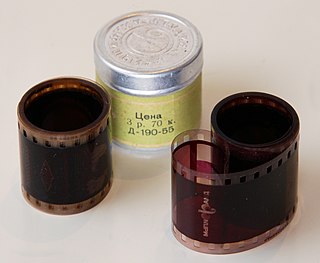Related Research Articles
Multimedia is a form of communication that combines different content forms such as text, audio, images, animations, or video into a single presentation, in contrast to traditional mass media, such as printed material or audio recordings. Popular examples of multimedia include video podcasts, audio slideshows and Animated videos.

A panorama is any wide-angle view or representation of a physical space, whether in painting, drawing, photography, film, seismic images or a three-dimensional model. The word was originally coined in the 18th century by the English painter Robert Barker to describe his panoramic paintings of Edinburgh and London. The motion-picture term panning is derived from panorama.

A slide projector is an opto-mechanical device for showing photographic slides.
In computing, a presentation program is a software package used to display information in the form of a slide show. It has three major functions:

An overhead projector (OHP), like a film or slide projector, uses light to project an enlarged image on a screen, allowing the view of a small document or picture to be shared with a large audience.

In photography, a negative is an image, usually on a strip or sheet of transparent plastic film, in which the lightest areas of the photographed subject appear darkest and the darkest areas appear lightest. This reversed order occurs because the extremely light-sensitive chemicals a camera film must use to capture an image quickly enough for ordinary picture-taking are darkened, rather than bleached, by exposure to light and subsequent photographic processing.

In optical engineering, the objective is the optical element that gathers light from the object being observed and focuses the light rays to produce a real image. Objectives can be a single lens or mirror, or combinations of several optical elements. They are used in microscopes, binoculars, telescopes, cameras, slide projectors, CD players and many other optical instruments. Objectives are also called object lenses, object glasses, or objective glasses.

An LCD projector is a type of video projector for displaying video, images or computer data on a screen or other flat surface. It is a modern equivalent of the slide projector or overhead projector. To display images, LCD projectors typically send light from a metal-halide lamp through a prism or series of dichroic filters that separates light to three polysilicon panels – one each for the red, green and blue components of the video signal. As polarized light passes through the panels, individual pixels can be opened to allow light to pass or closed to block the light. The combination of open and closed pixels can produce a wide range of colors and shades in the projected image.

A slide show is a presentation of a series of still images on a projection screen or electronic display device, typically in a prearranged sequence. The changes may be automatic and at regular intervals or they may be manually controlled by a presenter or the viewer. Slide shows originally consisted of a series of individual photographic slides projected onto a screen with a slide projector. When referring to the video or computer-based visual equivalent, in which the slides are not individual physical objects, the term is often written as one word, slideshow.

The filmstrip is a form of still image instructional multimedia, once commonly used by educators in primary and secondary schools (K-12), overtaken at the end of the 1980s by newer and increasingly lower-cost full-motion videocassettes and later on by DVDs. From the 1940s to 1980s, filmstrips provided an easy and inexpensive alternative to 16 mm educational films, requiring very little storage space and being very quick to rewind for the next use. Filmstrips were large and durable, and rarely needed splicing. They are still used in some areas.
The Trachtenburg Family Slideshow Players were an American indie-rock/art pop family band. It consisted of main vocalist Jason Trachtenburg, his wife Tina, and their only child, Rachel.

A slide viewer is a device for looking at film transparencies or similar photographic images.
A large-format slide projector is a kind of slide projector for large image projection which has a very powerful light source. Therefore, it is necessary to use a large slide format to protect the slide material from overheating during the projection process. Slide formats include 18 × 18 cm or 24 × 24 cm.

Camille Anna Paglia is an American feminist academic and social critic. Paglia has been a professor at the University of the Arts in Philadelphia, Pennsylvania, since 1984. She is critical of many aspects of modern culture and is the author of Sexual Personae: Art and Decadence from Nefertiti to Emily Dickinson (1990) and other books. She is also a critic of contemporary American feminism and of post-structuralism, as well as a commentator on multiple aspects of American culture such as its visual art, music, and film history.

A projector or image projector is an optical device that projects an image onto a surface, commonly a projection screen. Most projectors create an image by shining a light through a small transparent lens, but some newer types of projectors can project the image directly, by using lasers. A virtual retinal display, or retinal projector, is a projector that projects an image directly on the retina instead of using an external projection screen.

Multi-image is the now largely obsolete practice and business of using 35mm slides (diapositives) projected by single or multiple slide projectors onto one or more screens in synchronization with an audio voice-over or music track. Multi-image productions are also known as multi-image slide presentations, slide shows and diaporamas and are a specific form of multimedia or audio-visual production.
A slide-tape work is an audiovisual work consisting of a slide show using a filmstrip machine with synchronised accompanying audio, traditionally audio tape. These have frequently been used for education and for tourism, but also include artistic uses.
A slide show is an on-screen presentation of information/ideas presented on slides. Forms of slideshows include:
Kandy Fong created the first fan videos in 1975, a slideshow of Star Trek images set to music. She is credited with creating the concept of "mash-ups", editing a TV show or a film by disconnecting the images from the original soundtrack and re-editing them to a song to tell a new story. Fong's media practice includes zine editing, short story writing, slideshow creation and sketch comedy.
The etymological meaning of the word audiovisualogy is linked, on the one hand, with the term audiovisual, referring to the means jointly related to the view and the hearing and, on the other hand, to the suffix logy, that refers to logos, and that in Greek means treaty, knowledge. Therefore, audiovisualogy must be understood as a study of the audiovisual media that, due to its broad meaning, could be related to either the cinema, the television or any other art.